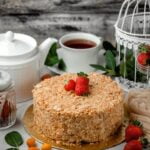Are you a beginner baker looking to spruce up your cake decorating skills? Look no further. In this article, we will guide you through the process of decorating a cake with fondant.
Whether you’re preparing for a special occasion or just want to impress friends and family, mastering the art of fondant decoration is sure to take your baking game to the next level. From essential tools and materials to troubleshooting common issues, we’ve got you covered with everything you need to know about fondant decorating.
When it comes to cake decorating, using fondant can bring your creations to life in ways that traditional frosting simply can’t. If you’re new to the world of fondant, don’t worry – we’ll walk you through the process step by step, providing tips and techniques for beginners along the way. By the end of this article, you’ll be ready to tackle your first fondant-decorated cake with confidence and creativity.
In the following sections, we’ll start by discussing the essential tools and materials you’ll need for fondant cake decorating. Then we’ll move on to preparing the cake for fondant decoration and choosing the right type of fondant for your specific needs. After that, we’ll dive into a step-by-step guide on covering a cake with fondant and explore basic decoration techniques perfect for beginners.
Finally, we’ll provide troubleshooting tips and even some advanced techniques for those who are ready to take their skills to the next level. Let’s get started on your journey as a beginner in the art of fondant cake decorating.
Essential Tools and Materials for Fondant Cake Decorating
When it comes to creating beautifully decorated cakes with fondant, having the right tools and materials is essential for success. As a beginner in fondant cake decorating, it’s important to have a good understanding of what you’ll need to get started. Here are some essential tools and materials for fondant cake decorating:
Rolling Pin and Fondant Smoother
A quality rolling pin is essential for rolling out your fondant to the desired thickness. Look for a non-stick rolling pin to make the process easier. A fondant smoother is also necessary for smoothing out the fondant once it’s placed on the cake.
Fondant Mat or Non-Stick Surface
Having a clean, smooth surface to work on when rolling out your fondant is crucial. A silicone or vinyl fondant mat can provide a non-stick surface and make transferring the rolled-out fondant onto the cake much easier.
Fondant Tools
Investing in a set of fondant tools can be incredibly helpful for shaping, cutting, and adding detail to your fondant decorations. Look for a set that includes various shaping tools, cutters, and embossers.
Dusting Pouch and Cornstarch/Powdered Sugar
To prevent your fondant from sticking to the work surface or tools, it’s important to have a dusting pouch filled with either cornstarch or powdered sugar. This will allow you to lightly dust the surface as needed while working with the fondant.
Edible Food Colors and Paint Brushes
If you plan on coloring your fondants, having a variety of edible food colors on hand will give you flexibility in creating vibrant decorations. Additionally, small paint brushes can be used with food colorings or luster dusts for painting details onto your decorations.
By ensuring that you have these essential tools and materials on hand, you’ll be well-equipped to begin your journey into the world of fondant cake decorating. These items will set you up for success as you learn basic techniques and start creating beautiful designs on your cakes.
Preparing the Cake for Fondant Decoration
When it comes to decorating a cake with fondant, the preparation of the cake is just as important as the actual fondant application. Preparing the cake properly will ensure that your fondant adheres smoothly and flawlessly, giving you a beautiful finished product.
Leveling and Crumb Coating
Before applying fondant, it’s essential to level your cake to ensure a flat and even surface. Use a serrated knife or a cake leveler to carefully trim off any domed or uneven areas. Once your cake is level, apply a thin layer of buttercream icing all over the cake to seal in any loose crumbs. This crumb coat will help the fondant adhere better and prevent any unsightly crumbs from showing through the finished covering.
Chilling the Cake
After applying the crumb coat, it’s important to chill the cake in the refrigerator for at least 30 minutes. Chilling will help firm up the buttercream icing, making it easier to work with when applying the fondant. Additionally, a chilled cake provides a more stable surface for fondant application and reduces the risk of smudging or misshaping the fondant during handling.
Covering the Cake Board
While not directly related to preparing the cake itself, covering the cake board with fondant can add a professional touch to your finished product. Before placing your chilled and crumb-coated cake on its serving board or platter, roll out some additional fondant and cover the board with it. Use a sharp knife or pizza cutter to trim off any excess fondant around the edges of the board for a clean finish.
By following these steps for preparing your cake before applying fondant, you’ll create an ideal surface for smooth and flawless decoration, setting you up for success as you continue on your journey as a beginner in fondant decorating.
Tips for Choosing the Right Fondant for Your Cake
When it comes to choosing the right fondant for your cake, there are a few key factors to consider. The type of fondant you use can impact the taste, texture, and overall look of your finished cake. Here are some tips to help you choose the best fondant for your decorating project:
- Consider the flavor: Some fondants have a plain, vanilla flavor, while others come in a variety of flavors such as chocolate, almond, or even fruit flavors. Think about what flavor will complement the taste of the cake you are decorating.
- Texture matters: Fondant can vary in texture from very soft and pliable to firm and less elastic. The texture you choose will depend on the design you want to achieve and your personal preference for working with different consistencies.
- Color options: Some fondants come pre-colored, while others are white and can be tinted with food coloring. Consider whether you want to work with pre-colored fondant or customize the color yourself.
It’s also important to choose a high-quality fondant that is easy to work with and provides a smooth finish on your cake. Reading reviews or getting recommendations from experienced decorators can help you select a brand or type of fondant that is known for its ease of use and professional results.
Lastly, consider the climate and storage conditions in which you will be working. Some fondants are more sensitive to heat and humidity, so if you live in a hot or humid climate, you’ll want to choose a fondant that is designed to withstand these conditions without becoming too sticky or difficult to work with.
By keeping these factors in mind, you can choose the perfect fondant for your cake decorating project and set yourself up for success as a beginner decorator.
Step-by-Step Guide to Covering a Cake With Fondant
Covering a cake with fondant may seem intimidating for beginners, but with the right techniques and practice, it can be an achievable and satisfying skill to learn. The first step in covering a cake with fondant is to ensure that you have a smooth and properly prepared base.
This includes leveling the top of the cake, applying a thin layer of frosting or jam to act as an adhesive for the fondant, and chilling the cake in the refrigerator for at least 30 minutes to set.
Once your cake is ready, sprinkle some powdered sugar on a clean surface and roll out your fondant into a circle that’s about 2 inches larger than the diameter and height of your cake. Use a rolling pin to carefully transfer the fondant onto the top of your cake, then gently smooth it over the sides using fondant smoothers. Take care not to trap any air bubbles underneath the fondant as you work.
After your fondant is smoothly applied, use a sharp knife or pizza cutter to trim off any excess fondant from around the base of the cake. If there are any creases or pleats in your fondant, use a fondant smoother to gently smooth them out. Once you’ve achieved a smooth finish, allow your covered cake to set for at least 1 hour before adding any additional decorations or designs. Congratulations. You’ve successfully covered your first cake with fondant.
| Step | Description |
|---|---|
| 1 | Prepare the base of the cake by leveling it, applying frosting or jam, and chilling it in the refrigerator. |
| 2 | Roll out the fondant into a circle larger than the cake, place it on top of the cake, and smooth it over while being mindful of air bubbles. |
| 3 | Carefully trim off excess fondant and smooth out any creases or pleats using smoothers. |
Basic Fondant Decoration Techniques for Beginners
Once you have covered your cake with fondant, it’s time to add some decorative touches to make it really stand out. Here are some basic fondant decoration techniques that are perfect for beginners:
1. **Cut-Out Shapes**: Using cookie cutters or specialized fondant cutters, you can create cute shapes like hearts, flowers, and stars to adorn your cake. Simply roll out the fondant to your desired thickness, press the cutter into the fondant, and carefully lift the shape onto your cake.
2. **Embossing**: This technique involves pressing a pattern or design into the fondant using embossing tools or even household items like lace or textured fabric. It adds an elegant touch to your cake without requiring advanced skill.
3. **Simple Borders**: Adding a border around the base or top of your cake can give it a polished look. You can use a rope mold for a classic twisted border, or try rolling thin strips of fondant and arranging them in various patterns.
Using these basic techniques, you can elevate your fondant-covered cake from simple to stunning without feeling overwhelmed by complicated designs or methods.
| Tool | Description |
|---|---|
| Fondant Cutters | Specialized tools for cutting out shapes in fondant |
| Embossing Tools | Tools used to create patterns and designs on fondant |
| Rope Mold | A tool used for creating twisted borders on cakes |
Troubleshooting Common Fondant Decorating Issues
When decorating a cake with fondant, it is common to encounter some issues that may arise during the process. Understanding how to troubleshoot these problems can help ensure that your final product looks as beautiful as you envisioned. Here are some common fondant decorating issues and how to solve them:
- Issue: Cracks or Tears in the Fondant
- Issue: Fondant Bulging or Sagging
- Issue: Uneven or Lumpy Fondant Surface
If you notice cracks or tears in the fondant while covering your cake, it could be due to dry or overworked fondant. To fix this issue, try kneading the fondant again to make it more pliable before reapplying it to the cake. You can also use a small amount of water to smooth out any imperfections.
Bulging or sagging fondant can occur when air becomes trapped between the cake and the fondant. To prevent this issue, ensure that your cake is properly leveled and chilled before applying the fondant. If you notice bulging after covering the cake, gently press down on the affected areas to release any trapped air.
If your fondant looks uneven or lumpy after covering the cake, it may be due to improper rolling and smoothing techniques. To fix this issue, carefully reroll the fondant and apply it again using even pressure. Use a fondant smoother to gently smooth out any lumps or imperfections.
By being aware of these common issues and knowing how to troubleshoot them, you can tackle any challenges that arise while decorating a cake with fondant. With practice and patience, you’ll be able to create beautifully decorated cakes that will impress everyone at your next celebration.
Advanced Techniques for Taking Your Fondant Decorating to the Next Level
Once you have mastered the basic fondant decoration techniques, you may want to explore more advanced techniques to take your cake decorating skills to the next level. One advanced technique that can elevate your fondant decorating is creating intricate designs and patterns on the fondant.
This can be achieved using various tools such as embossing mats, impression mats, and stencils. These tools can help you create beautiful textures and patterns on the fondant that will impress anyone who sees your cake.
Another advanced technique to consider is creating 3D decorations with fondant. This can include sculpting figurines, flowers, or other intricate shapes using fondant. To achieve this, you will need to practice working with different consistencies of fondant and using specialized shaping tools such as modeling tools and veining tools. The ability to create detailed and realistic 3D decorations will truly set your cakes apart and showcase your artistic talents.
Additionally, learning how to create ombré effects, marbling, and other advanced color techniques with fondant can add a stunning visual element to your cakes. With these techniques, you can blend different colors of fondant seamlessly or create eye-catching designs using multiple shades of fondant.
Mastering these advanced color techniques will allow you to customize the look of your cakes and bring your creative vision to life in a unique and impressive way. By continuing to practice these advanced techniques, you will expand your skill set as a fondant cake decorator and have the confidence to tackle even more challenging cake decorating projects in the future.
Conclusion
In conclusion, decorating a cake with fondant can seem intimidating at first, but with the right tools, materials, and techniques, even beginners can create beautiful and professional-looking designs. As you embark on your fondant decorating journey, it’s important to remember that practice makes perfect. Don’t be discouraged by any initial struggles or mishaps – troubleshooting common issues is all part of the learning process.
Once you have successfully covered and decorated your first fondant cake, take a moment to celebrate your achievement. Whether it’s a simple design or something more elaborate, completing a fondant-decorated cake as a beginner is no small feat. Share your creation with friends and family, and don’t forget to give yourself credit for stepping out of your comfort zone and trying something new.
As you continue to gain experience with fondant decorating, consider exploring advanced techniques to elevate your skills to the next level. There are endless possibilities for creating stunning designs with fondant, so enjoy the learning process and embrace the creativity that comes with decorating cakes. Remember that every masterpiece starts with a single step, and with dedication and perseverance, you can become a confident and skilled fondant cake decorator.
Frequently Asked Questions
How Do You Decorate a Cake With Fondant Icing for Beginners?
Decorating a cake with fondant icing for beginners involves a few key steps. First, you’ll want to ensure that your cake is level and smooth before covering it with a thin layer of buttercream or jam to help the fondant stick.
Then, roll out the fondant to the desired thickness on a surface dusted with powdered sugar and carefully drape it over the cake. Smooth out any wrinkles or air bubbles, trim off any excess fondant, and then you can add additional decorations or details using more fondant as desired.
Should You Chill a Cake Before Putting Fondant on It?
It is generally recommended to chill a cake before putting fondant on it, especially if it has been freshly frosted with buttercream. Chilling the cake helps the buttercream set and firm up, creating a smoother surface for applying the fondant.
However, be sure not to chill the cake for too long or else condensation can form on the surface when it’s removed from the refrigerator, potentially causing issues when applying the fondant.
How Do You Get Fondant to Stick to a Cake?
Getting fondant to stick to a cake requires applying some kind of adhesive to the surface of the cake first. This can be done by brushing a light coat of simple syrup (equal parts sugar and water heated until dissolved) or by spreading a thin layer of buttercream or jam onto the cake before placing the fondant over it.
The moisture in these adhesives helps create a sticky surface for the fondant to adhere to, allowing for a smooth and clean finish once decorated.

Welcome to my blog about home and family. This blog is a place where I will share my thoughts, ideas, and experiences related to these important topics. I am a stay-at-home mom with two young children. I hope you enjoy reading it! and may find some helpful tips and ideas that will make your home and family life even better!





